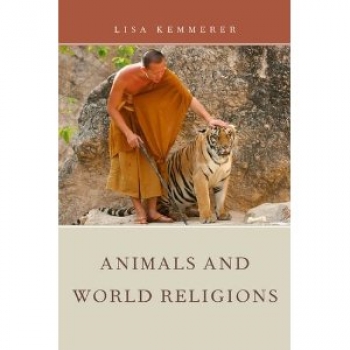The dire condition of Earth’s environment and our relationship with nature may often be drowned out by the daily debate of politics, economics, or celebrity gossip and vanity media. But this din should not distract us from one naked fact: the issues around the world ecology will always remain the most critical questions of each generation. Without the natural world, there is no hope for flourishing in any realm of human activity. So it would seem natural that all religions claiming spiritual authority and insight into humanity’s ultimate fate maintain an unashamedly moral appreciation of ecological sustainability.
Lisa Kemmerer’s new volume of Animals and World Religions (2012) is academically erudite and discerning, employing the theological methodologies that she has accumulated over her career of research and teaching. But as a philosopher-activist, her language is not one of detached study but of urgent ethical practice. In other words, while easy to follow, Kemmerer’s analysis confronts the reader (in particular the religious believer) with some very clear lifestyle choices that are grounded in the great religion’s animal theologies. Therefore, unlike other books on religions’ relationships with the natural world, Animals and World Religions is more challenging and honest in its argumentation.
The Buddha was aware of how language frames the way we see the world and how we treat it. It is with this reverential awareness in mind that Kemmerer writes about animals as “anymals” (and it should be appropriate that we do likewise), for by imposing the word “any” on to a word we do not delude ourselves that humans are different from “animals”. Kemmerer covers the extant world religions (indigenous, Hindu, Buddhist, Chinese, Jewish, Christian, and Islamic) in her analysis of anymal theology. We were most convinced by her arguments in the Buddhist chapter (pg. 91 – 126). She covers an entire breadth of narratives underpinning the Buddhist stance; almost the entire gamut of Buddhist arguments is deployed in her philosophical arsenal: non-harm, the jataka tales, metta and karuna, the bodhisattva ideal, the precepts, the afterlife and interdependence, and more. We are convinced that Buddhism has traditionally offered the strongest arguments for anymal care. The chapter on Chinese traditions (pg. 127 – 168) should also be pertinent to a growing affluent class in China that, in the rush for a Western-style diet of meat or traditional luxuries like shark fin, rhino horn, and ivory, forgets that the deepest, foundational religions of Chinese civilization encourage benevolence (ren) through Confucianism and frugality and simplicity (jian) through Taoism.
We cannot speak for the other great religions’ ethics, but Kemmerer’s underlying point is consistent throughout each chapter: there is no extant religion that would conceivably


















